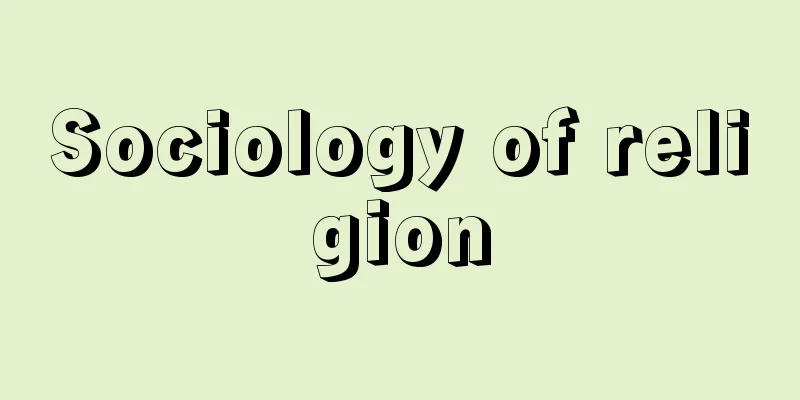Sociology of religion

|
It is generally considered to be a branch of special sociology that studies religious phenomena from a sociological perspective, but in theory, the sociological elucidation of religion is given a central position in understanding social integration. Early outstanding empirical studies on the relationship between religion and social structure include Fustel de Coulanges's The Ancient Cities (1864) and W. R. Smith's The Religions of the Semitic Peoples (1889), but the foundations of the sociology of religion were laid by the great masters of sociology, E. Durkheim of France and M. Weber of Germany. Although the two men differed considerably in their research perspectives and methods, they agreed that non-rational elements (religion) were important foundations for social integration, in a time when the general trend was to view rational elements as the principle of social integration rather than non-rational elements. Durkheim made this clear through his analysis of "Elementary Forms of Religious Life" (1912). His research had a great influence on the later development of anthropological studies of religion. In particular, it became the basis for research by British scholars such as A. R. Radcliffe-Brown and B. Malinowski on the function of religion in strengthening social solidarity and its function in everyday life. Weber clarified through his research in "The Protestant Ethic and the Spirit of Capitalism" (1904-05) that the emergence of modern capitalism in Western Europe was due to the formation of a new value system (ethos), and that religion, as a non-rational element, was involved in the establishment of these values as its foundation. He developed this issue into his comparative sociological study of World Religions and Economic Ethics (1915-20), in which he clarified many of the perspectives and concepts necessary for the sociology of religion. This work became a model for recent studies attempting to elucidate the relationship between the modernization of traditional societies and religion. One example is the study by American R.N. Bellah in Modernization of Japan and Religious Ethics (1957). Durkheim's and Weber's perspectives have been reevaluated from a broader perspective in recent years. T. Parsons of the United States positions religion as the basis for the meaning of values that internally support social life, while P. L. Berger and T. Luckmann, influenced by phenomenological sociology, have attempted to elucidate the role of religion in ultimately giving meaning to social order. There have also been studies on types of religious groups by E. Troeltsch and J. Wach, who are followers of German sociology. In particular, the latter's distinction between synchronous religious groups, in which the religious group coincides with natural groups (family, village, ethnic group), and unique religious groups founded by a founder, has become the standard for typifying religious groups. In addition, multifaceted and diverse research is being conducted to clarify the relationship between religion and society. Although these studies have not yet been fully organized in terms of theory and methodology, today sociological research on religion is actively conducted from the perspective that it is important for deepening understanding of the basic nature of the survival and development of society. [Kuchiba Masuo] "Sociology of Religion" by M. Weber, translated by Kazuo Muto, Munehito Sonoda, and Tan Sonoda (1976, Sobunsha)" "Introduction to Modern Sociology 5: Sociology of Religion" by T. Oddie, translated by Iwao Munakata (1968, Shiseido) " "The Sacred Canopy: A Sociology of the Sacred World" by P.L. Berger, translated by Minoru Sonoda (1979, Shinyosha)" [References] | | |Source: Shogakukan Encyclopedia Nipponica About Encyclopedia Nipponica Information | Legend |
|
一般に宗教現象を社会学的視角から研究する特殊社会学の一部門とされているが、理論上、宗教の社会学的解明は社会統合を理解するうえで中心的な位置を与えられている。宗教と社会構造の関連に関する初期の優れた実証研究にはフュステル・ド・クーランジュの『古代都市』(1864)やW・R・スミスの『セム族の宗教』(1889)があるが、宗教社会学の基礎を築いたのは、フランスのE・デュルケームとドイツのM・ウェーバーという社会学の巨匠である。 両者は研究の視角や方法においてかなり異なっているが、非合理的要素よりも合理的要素を社会の統合原理とする傾向の強かった当時の一般思潮のなかで、非合理的要素(宗教)を社会統合の重要な基礎としての意味をもつものであると指摘した点で一致している。この点について、デュルケームは『宗教生活の原初形態』(1912)の分析によって明らかにしている。彼の研究は後の人類学の宗教研究の展開に大きな影響を与えた。とくにイギリスのA・R・ラドクリフ・ブラウンやB・マリノフスキーなどによる宗教の社会的連帯強化の機能や宗教の日常生活における機能の研究の基礎となった。ウェーバーは、西欧における近代資本主義の発生が新しい価値観(エートス)の形成によるものであり、この価値観の樹立に非合理的要素としての宗教が、その基盤として関与していることを『プロテスタンティズムの倫理と資本主義の精神』(1904~05)の研究によって解明した。彼はこの問題を比較社会学的な『世界宗教と経済倫理』(1915~20)の研究に展開させ、宗教社会学に必要な多くの視点や概念を明確にした。こうした研究は、伝統社会の近代化と宗教との関係を解明しようとする近年の諸研究のモデルとなった。アメリカのR・N・ベラーによる『日本近代化と宗教倫理』(1957)の研究も、その一例である。 デュルケームとウェーバーの視点は、近年さらに広い視野から再評価され、アメリカのT・パーソンズは、社会生活を内面的に支える価値観を意味のうえで根拠づけるものとして宗教を位置づけ、現象学的社会学の影響を受けているP・L・バーガーやT・ルックマンは、社会秩序を究極的に意味づける宗教の役割解明を試みている。またドイツ社会学の流れをくむE・トレルチやJ・ワッハによる宗教集団の類型の研究もある。とくに後者による自然集団(家族、村落、民族)と宗教集団が一致している合致的宗教集団や開祖による創唱的特殊宗教集団の区分は、宗教集団類型の基準となっている。このほか、宗教と社会の関係解明のために多角的に多方面にわたる研究が行われている。このような諸研究は理論や方法のうえで、いまだ十分に整理されてはいないが、今日では宗教の社会学的研究は、社会の存続と発展の基本的性質の理解を深めるのに重要な意味をもつとの観点から盛んに行われている。 [口羽益生] 『M・ウェーバー著、武藤一雄・薗田宗人・薗田坦訳『宗教社会学』(1976・創文社)』▽『T・オディ著、宗像巌訳『現代社会学入門5 宗教社会学』(1968・至誠堂)』▽『P・L・バーガー著、薗田稔訳『聖なる天蓋――神聖世界の社会学』(1979・新曜社)』 [参照項目] | | |出典 小学館 日本大百科全書(ニッポニカ)日本大百科全書(ニッポニカ)について 情報 | 凡例 |
<<: Employed population - working population
>>: School of Religious History - Religionsgeschichtliche Schule
Recommend
Profit Debate - Rejunronso
Economic debate in the Soviet Union in the early 1...
Evolution - Shinka (English spelling) evolution English
This refers to the changes that occur in living o...
Song Dynasty Art (English: Song Dynasty Art)
The Song dynasty (960-1279) is divided into the No...
Kawakita [town] - Kawakita
A town in Nomi County in the southern part of Ishi...
Maleic Anhydride - Maleic Anhydride
2,5-furandione. C 4 H 2 O 3 (98.06). In industria...
Kasama ware
A regional brand of Ibaraki Prefecture in the Kant...
Phronimella elongata (English spelling) Phronimella elongata
...The closely related Phronimella stebbingi ( P....
Summary calculation method
A book on Japanese mathematics. Published in 1712 ...
Crows; choughs
A general term for birds in the family Corvidae, s...
kikimora
…Just as in the house, there were place spirits: ...
Akagi
Akagi Village was formerly a village in Seta Dist...
Kanem Empire
In the late 14th century, the nomadic Bulala peop...
The Temptation of the Wilderness
The deeds of Jesus as told in Mark 1:12-13, Matthe...
Isazumi Shrine
It is located in Miyabayashi, Aizumisato-cho, Onu...
Alt, Albrecht Georg
[Born] 1883 [Died] 1956 German Old Testament schol...





![Bhaskara [II] - Bhaskara](/upload/images/67cc84cd7a089.webp)



